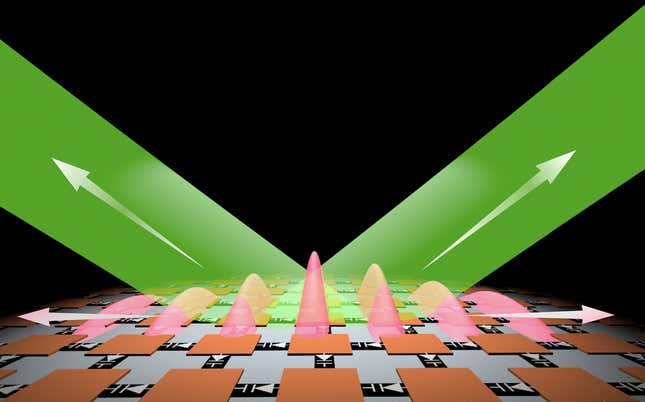
A team of researchers designed a two-dimensional photonic time crystal that they say could have applications in technologies like transmitters and lasers.
Despite their name, photonic time crystals have little in common with time crystals, a phase of matter first proposed in 2012 and observed several years later. The fundamental commonality is that both crystals have structural patterns over time, but time crystals are quantum materials—the atoms are suspended in quantum states—while photonic time crystals are artificial materials not found in nature and they are not necessarily suspended in quantum states.
Researchers have had difficulty building and manipulating 3D photonic time crystals, so the recent team tried something different: slimming down the material to a mere 0.08 inches (2 millimeters) thick. Their crystal amplifies light at microwave frequencies. The experiment results are published today in Science Advances.
“By modulating or changing the electromagnetic property of the metasurface over time, we were able to create a 2D photonic time crystal,” said Xuchen Wang, a physicist at the Karlsruhe Institute of Technology and the study’s lead author, in an email to Gizmodo. “Reducing photonic time crystals from 3D to 2D can make them thinner, lighter, and easier to manufacture, just like how metasurfaces improved on metamaterials.”
Photonic crystals are optical structures whose ability to refract light changes periodically (that is to say, over time). In lab settings, the electromagnetic properties of metamaterials can be fine-tuned to create photonic crystals that are unnaturally good at amplifying light waves.
Photons in such crystals have a repeating pattern that makes them coherent, similar to how laser patterns pulsed at quantum bits help keep them coherent, prolonging quantum states.
“In [photonic time crystals], energy is not conserved; hence the states residing in the momentum gap can have exponentially increasing amplitudes,” said Mordechai Segev, a physicist at the Technion Israel Institute of Technology who is unaffiliated with the new paper, in a February interview with Nature Photonics. “This has a huge impact on the physics involved.”
Real-world applications of the discovery involve most devices that rely on photonics. For example, wireless signals could be improved by coating devices in 2D photonic time crystals, making signal strengths more robust.
Though the crystal crafted by the team only amplifies microwave frequencies, Wang told Gizmodo that a slight tweak in the design could allow the crystal to work in millimeter-wave frequencies, like those used in 5G communications.
Time will tell how scaleable the technology is and how well it performs outside a lab.
More: Physicists Got a Quantum Computer to Work by Blasting It With the Fibonacci Sequence

